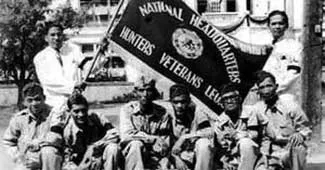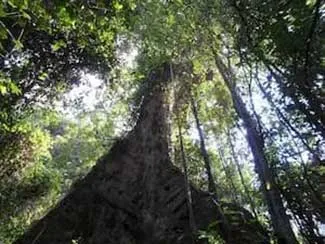Balayan: Historical and Folkloric Trivia about some of its Barrios
This article is part of a continuing series that attempts to bring to the Batangueño public and anyone else interested otherwise forgotten historic and folkloric trivia about the cities and municipalities of Batangas. The information contained herein comes from obscure documents required of Department of Education districts around the country in the fifties by the administration of then-President Elpidio Quirino. These documents are archived at the National Library of the Philippines Digital Collections.
Not all barrios had documents in these archives. If a barrio is not represented herein, it could be that it used to be part of another barrio in the fifties; no documented was written and/or submitted for it; and if one was, it was also possible that the document was destroyed and could not be scanned when the National Library of the Philippines started to digitize historic documents.
Here are the historic and folkloric trivia about some barrios of the Municipality of Balayan.
 |
| View of Church at Balayan. The old capital of Batangas. Image credit: Luther Parker Collection of the National Library of the Philippines Digital Collections. |
Calan
The name of Barrio Calan literally means a stove, but how it was given was not explained. The original families of this barrio were the Lopezes, Bascuguins, de Jesuses, de Castros, de Leons and Pagdunzulans. During the Philippine Revolution, “insurrecto” troops under Kapitan Inso and Kapitan Cleto, both from nearby Cavite, fought an encounter with Spanish troops in Calan and forced them to retreat. At the outbreak of the Philippine-American War, Calan became a refuge for Filipinos seeking to escape the brutality of the so-called Macabebe Scouts1. During the Japanese occupation, inhabitants of the barrio were forced to plant cotton instead of the sugarcane favored by the locals. Calan, because it was relatively isolated, was fortunate to have escaped the ravages of war suffered by other barrios of Batangas.
Source: History and Cultural Life of Calan
Canda
According to folklore, Canda’s name was taken from Kinanda, a variety of rice being planted by locals when Spanish explorers first ventured into the barrio. This species of rice is considered extremely rare in the present day2. Canda’s sitios in the 1950s were Ilaya (literally, “towards the interior”), Tumana (supposedly signifying meadows), Paluan (supposedly where an angry mother was whipping a naughty child), Mayantok (after yantok, a species of rattan), Pinkian (a crude device for starting fire), Prenza (supposedly a damming device used for irrigation) and Sambat (supposedly so-named after a crossroad or “Sagbat”).
Source: The Barrio of Canda
 |
| Barrio Canda was supposedly named after a now rare variety of rice called Kinanda. Image credit: Agriculture Farming. |
Dalig
Dalig was supposed to have been named after a type of stone, and indeed, there is also a barrio called Batong Dalig in Kawit, Cavite. This barrio was supposed to have been initially settled “in the middle of the Spanish regime” by the family of one Sergeant Francisco Garcia. The family would build its home in the northernmost part of the barrio, which would over time become known as Sarhento, a reference to Garcia’s rank. The barrio was fortunate to have escaped death and destruction during the Philippine Revolution, the Philippine-American War and even World War II.
Source: History and Cultural Life of the Barrio of Dalig
Dao
Dao was supposed to have been established in 1823. It was so named, according to folklore, because a band of tulisanes (outlaws or brigands) buried their loot near a large dao tree3 in the area. The barrios original settlers were the Ramoses and the Berroyas. During the early years of the American colonial era, Dao along with the barrios of Cacawitan and Lanitan were severely affected by an infestation of swarms of locust. Every inhabitant of Dao was obliged by the Teniente del Barrio to render service two days a week to seek and destroy the locusts.
Source: History and Cultural Life of the People in Dao
Dilao
According to folklore, Dilao’s name was from whose flowers and root crops were “very yellow.” Turmeric? During the latter part of the Spanish regime, inhabitants of the barrio starved and were often punished by the Spaniards even at the slightest offences. This forced many of them to join the revolutionary movement. In retaliation, the Spaniards burned the houses in the barrio. During the Japanese occupation, a group of the barrio’s inhabitants was put to work pounding rice for the Japanese but these inhabitants were still put to death after they finished their work.
Source: History and Cultural Life of Dilao
Duhatan
Duhatan, or Ruhatan as it was alternatively called, was likely named after the duhat fruit, called the black or Java plum in English4. The fruit was said to have grown in abundance in the place. Duhatan was supposed to have been initially settled by families from Calaca and Nasugbu, who cleared the forest for rice and later sugarcane planting. During the Philippine Revolution, many inhabitants of the barrio rallied to join the Katipunan’s defensive line at Looc in Nasugbu. During World War II, Duhatan became something of a ghost town as its inhabitants sought refuge from Japanese rule in evacuation centers in Lian and Nasugbu.
Source: History and Cultural Life of Duhatan
Gimalas
Gimalas’ name was supposed to have come from a beautiful maiden who once lived in the barrio whose name was Gima. It was sometimes also called Aplaya because of its proximity to the sea. The barrio was believed to have been initially settled by Aetas who would, however, be driven up into the mountains. In later years, the place would be settled by the Castromeros, Panaligans, Bautistas and Mendozas. During the Japanese occupation, many male inhabitants of Gimalas joined the guerilla movements and participated in operations against the invaders. These were likely the Rainbow Regiment or the Hunters/ROTC Guerillas, both of which were operating in Western Batangas.
Source: History and Cultural Life of Gimalas Barrio
 |
| Inhabitants of Gimalas likely joined up with the Hunters/ROTC Guerillas which operated in Western Batangas. Image credit: Expatch.org. |
Lagnas
The name Lagnas was probably given because of the pits that were caused by soil erosion during the rainy season. One of its sitios was called Cagayan because this was where a Moro bandit used to hide, and the name was presumably after Cagayan de Oro. Considered as the first inhabitants of the barrio were Domingo Adove, Vicente Castromero, and one Cabesa Francisco, more popularly known as Cabeza Ariko.
Source: History and Cultural Life of Lagnas
Magabe
Magabe supposedly got its name from a folkloric story which told of a young boy who called out to an older man, “mama,” and asked him why he was still tending to his plants in the evening, “gabe na” or “gabi na.” One wonders if the plant the man was tending was taro or “gabi” also in Tagalog. At any rate, the original settlers of this barrio were the families of Crispino Magpantay and Prudencia Creag. The earliest Tenientes del Barrio were Meliton Bahan, Faustino Martinez, Francisco Ilog, Eleuterio Venzon, Mariano Villaria, Felix Ramos and Pedro Maligaya. During the Spanish regime, one Fr. Polonio Bihis, presumably of Poblacion Balayan, evacuated to Magabe where he would preside over Masses, baptisms and marriages. Katipuneros also killed one Eugenio Bautista and his son.
Source: History and Cultural Life of Magabe
Nabotas
Nabotas (presently spelled Navotas), was supposed to have been so named because its river once overflowed and inundated the entire barrio. The barrio was once forested but was cleared by salt makers. For 43 years, Nabotas was part of Barrio Santol which was, in turn, a mere sitio of Canda. During the Japanese occupation, many evacuees from Cavite and Quezon went to Nabotas. Many would stay on even after the liberation of Batangas by the American forces.
Source: History of Nabotas
Pook
Pook, literally “place,” was according to folklore so named because “no one can court a lady in the barrio except for the men from the ‘pook’ alone.” The barrio was established “sometime in the 1800s” and its original families were the Ramoses, Ilaws, Bayonitos, Bayongans and Hernandezes. During the Spanish regime, the bravest man in the barrio, as long as he could speak a little Spanish, was elected Teniente del Barrio. During the American colonial era, anybody who could not pay ₱2 for the residence certificate was required to work for 15 days. During the latter part of the Japanese occupation, the barrio’s inhabitants were suspected of being part of the guerilla movement, so the houses were burned by the Japanese soldiers. The people of Pook, thus, had to evacuate to Nasugbu.
Source: History and Cultural Life of Pook
Sampaga
This barrio was supposedly named after the sampaguita, one of several plants belonging to the sampaga or jasmine family5. It might have been populated even before the arrival of the Spaniards. During the Japanese occupation, one inhabitant of the barrio whose name was Mariano Betis was shot by Japanese soldiers after he shouted “Hapon!” to warn other people of the barrio and started to run. Another inhabitant of the barrio whose name was Arcadio was shot when he was trying to cross the Japanese defensive lines established at the Gimalas River. He was supposedly carrying a letter to the Americans, presumably with intelligence information.
Source: History and Cultural Life of the Barrio of Sampaga
 |
| Sampaga was supposed to have been named after the sampaguita. Image credit: My Sweet Painted Dreams. |
San Piro
According to folklore, San Piro was originally “sapiro,” a type of fish. Other elders, however, maintained that the name was a corruption of San Pedro. San Piro is supposed to have been Balayan’s oldest barrios and was believed to have been once ruled by a Datu. During the Philippine Revolution, the Battle of Palikpikan between the Spaniards and the Filipino insurgents occurred in this barrio. In 1945, Japanese forces established a defensive foothold in the barrio until ousted by American forces, backed by local guerrillas.
Source: History and Cultural Life of Barrio San Piro
2 “Batangas town fails to cash in on brown rice’s new popularity,” by Ariel J. Margen, published 6 October 2003, online at What’s New with Asia Rice Foundation.
3 Dracontomelon dao is a tropical canopy tree that can be found in many Asian countries. Wikipedia.
4 “Duhat,” online at Philippine Medicinal Plants.
5 “Sampaga,” Wikipedia.

